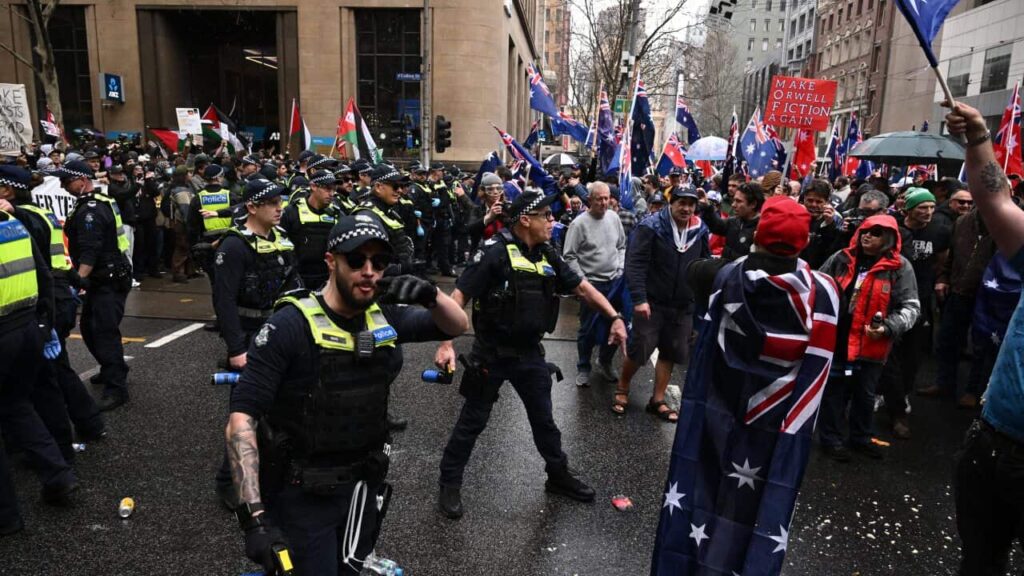
Thousands gathered across Australia for anti-immigration rallies dubbed “March for Australia,” igniting a wave of counter-protests in major cities. The rallies, organized to protest what participants call the government’s “mass migration” policy, were met with condemnation from government officials and concerns from community leaders about potential targeting of migrants.
In cities from Sydney to Melbourne, demonstrators carried Australian flags and chanted nationalist slogans, demanding a reduction in immigration. Despite the fervent calls for change, the Australian Bureau of Statistics has challenged claims circulating on social media that 1,500 migrants arrive daily, labeling these figures inaccurate.
Nationalist Chants and Counter-Protests
March for Australia rallies took place in all capital cities and several smaller towns, with participants advocating for a decrease in migration numbers. Many attendees displayed Australian flags and shouted slogans such as “love it or leave it,” emphasizing a nationalist sentiment. A prominent banner in Sydney read, “time to put Australia first,” capturing the rally’s core message.
While some participants insisted their stance was not anti-migration but rather against high migration levels, counter-protests erupted in response. In Melbourne, clashes between the two groups turned violent, prompting police to deploy pepper spray and baton rounds to maintain order. An estimated 5,000 people participated across various protests, according to police reports.
“The priority for police was to separate opposing groups and prevent breaches of the peace,” Victoria Police stated.
Similar tensions were observed in Brisbane and Canberra, where police formed lines to keep opposing groups apart. In Canberra, a scuffle broke out when an anti-fascism protester was placed in a headlock by a man draped in an Australian flag.
Political Figures and Arrests
Prominent political figures addressed the rallies, including One Nation leader Pauline Hanson, who spoke in Canberra. Known for her nationalist views, Hanson reiterated her stance, saying, “If you don’t love it, I’ll be the first one to take you to the airport and put you on a plane.”
Bob Katter, leader of Katter’s Australia Party, also addressed crowds in Townsville, having previously made headlines for controversial remarks regarding his heritage. White nationalist Thomas Sewell, a leader of the neo-Nazi group National Socialist Network, spoke in Melbourne, although the official March for Australia Instagram account distanced itself from him.
Throughout the day, multiple arrests were made. In Melbourne, six individuals faced charges ranging from assaulting police to resisting arrest. Sydney police detained a woman for allegedly abusing a pro-Palestinian crowd, and three arrests were made in Adelaide, though no major disruptions were reported.
Government and Public Response
The Australian government, alongside various political leaders, voiced strong opposition to the rallies. Home Affairs Minister Tony Burke criticized the events, stating, “Nothing could be less Australian.” Multicultural Affairs Minister Anne Aly emphasized unity against divisive actions targeting migrant communities.
Opposition leader Sussan Ley called for calm and respect, denouncing violence and racism. The Greens also condemned the rallies, with anti-racism spokesperson Mehreen Faruqi attributing the rise in far-right sentiment to certain media and political influences.
“These rallies must be called out for what they are, acts of racist fearmongering and hate,” Faruqi stated.
Experts have highlighted misinformation as a driving force behind anti-immigration sentiment. Liz Allen, a demographer at the Australian National University, dismissed myths about migrants impacting wages and housing as “nonsense.” She noted that fear of being left behind fuels anti-immigration emotions.
“That loss of hope means fear can take over, and that’s a very powerful emotion at the heart of anti-immigration sentiment,” Allen explained.
The rallies underscore a growing tension within Australia over immigration policies, reflecting broader global debates on migration. As the nation grapples with these issues, the events of the March for Australia highlight the need for dialogue and understanding in addressing public concerns and misinformation.







